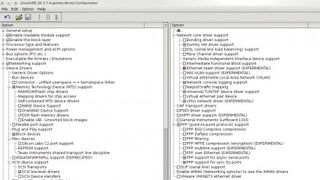What is Linux?
Linux explained
The Linux kernel is the beating heart of the system, but what is it? The kernel is the software interface to the computer's hardware. It communicates with the CPU, memory and other devices on behalf of any software running on the computer.
As such, it is the lowest-level component in the software stack, and the most important. If the kernel has a problem, every piece of software running on the computer shares in that problem.
The Linux kernel is a monolithic kernel – all the main OS services run in the kernel. The alternative is a microkernel, where most of the work is done by external processes, with the kernel doing little more than co-ordinating.

While a pure monolithic kernel worked well in the early days, when users compiled a kernel for their hardware, there are so many combinations of hardware nowadays that building them all into the kernel would result in a huge file.
So the Linux kernel is now modular, the core functions are in the kernel file (you can see this in /boot as vmlinuz-version) while the optional drivers are built as separate modules in /lib/modules (the .ko files in this directory).
For example, Ubuntu's 64-bit kernel is 5MB in size, while there are a further 3,700 modules occupying over 100MB. Only a fraction of these are needed on any particular machine, so it would be insane to try to load them all with the main kernel.
Instead, the kernel detects the hardware in use and loads the relevant modules, which become part of the kernel in memory, so it is still monolithic when loaded even when spread across thousands of files. This enables a system to react to changes in hardware.
Are you a pro? Subscribe to our newsletter
Sign up to the TechRadar Pro newsletter to get all the top news, opinion, features and guidance your business needs to succeed!
Plug in a USB memory stick and the usb-storage module is loaded, along with the filesystem module needed to mount it. In a similar way, connect a 3G dongle, and the serial modem drivers are loaded. This is why it is rarely necessary to install new drivers when adding hardware; they're all there just waiting for you to buy some new toys to plug in.
Computers that are run on specific and unchanging hardware, such as servers, usually have a kernel with all the required drivers compiled in and module loading disabled, which adds a small amount of security.
If you are compiling your own kernel, a good rule of thumb is to build in drivers for hardware that is always in use, such as your network interface and hard disk filesystems, and build modules for everything else.
Even more modules
The huge number of modules, most of which are hardware drivers, is one of the strengths of Linux in recent years – so much hardware is supported by default, with no need to download and install drivers from anywhere else. There is still some hardware not covered by in-kernel modules, usually because the code is too new or its licence prevents it being included with the kernel (yes ZFS, we're looking at you).
The drivers for Nvidia cards are the best known examples. Usually known as third-party modules, although Ubuntu also refers to 'restricted drivers', these are installed from your package manager if your distro supports them.
Otherwise, they have to be compiled from source, which has to be done again each time you update your kernel, because they are tied to the kernel for which they were built.
There have been some efforts to provide a level of automation to this, notably DKMS (Dynamic Kernel Module Support), which automatically recompiles all third-party modules when a new kernel is installed, making the process of upgrading a kernel almost as seamless as upgrading user applications.
Phrases that you will see bandied about when referring to kernels are "kernel space" and "user space". Kernel space is memory that can only be accessed by the kernel; no user programs (which means anything but the kernel and its modules) can write here, so a wayward program cannot corrupt the kernel's operations.
User space, on the other hand, can be accessed by any program with the appropriate privileges. This contributes towards the stability and security of Linux, because no program, even running as root, can directly undermine the kernel.
Current page: What is the Linux kernel?
Prev Page What is Linux? Next Page What is the Linux desktop?